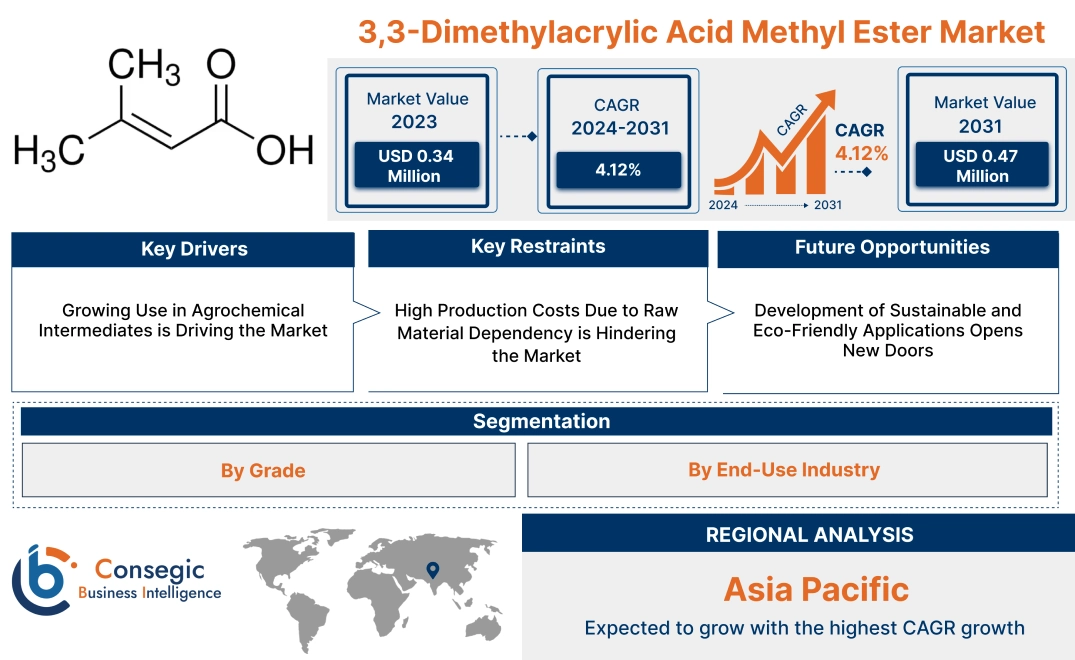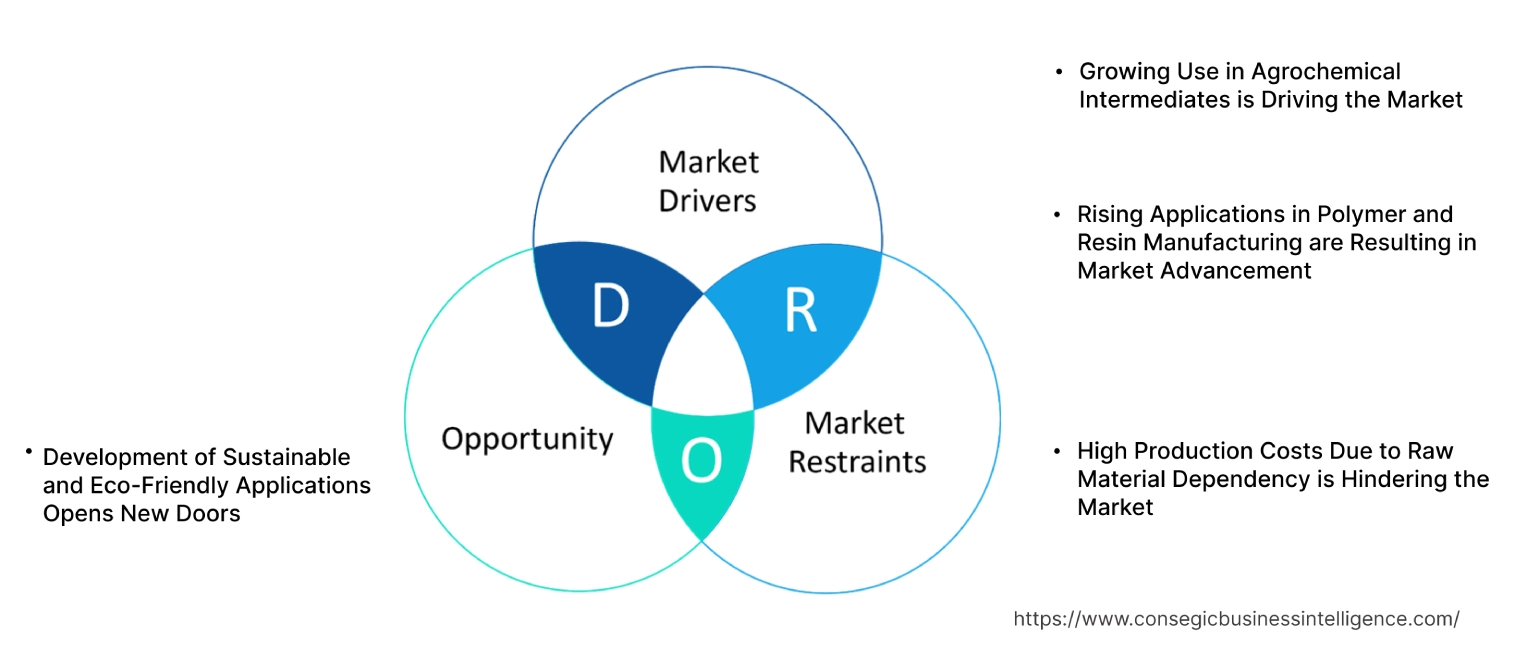- Summary
- Table Of Content
- Methodology
3,3-Dimethylacrylic Acid Methyl Ester Market Size:
3,3-Dimethylacrylic Acid Methyl Ester Market size is estimated to reach over USD 0.47 Million by 2031 from a value of USD 0.34 Million in 2023 and is projected to grow by USD 0.35 Million in 2024, growing at a CAGR of 4.12% from 2024 to 2031.
3,3-Dimethylacrylic Acid Methyl Ester Market Scope & Overview:
3,3-dimethylacrylic acid methyl ester represents a specialized chemical intermediate often employed in the synthesis of advanced materials and fine chemicals. It features an unsaturated molecular structure that supports various transformation pathways, enabling its incorporation into polymers, agrochemicals, pharmaceuticals, and specialty additives. This compound demonstrates consistent quality, controlled reactivity, and good thermal stability, ensuring reliable performance in diverse production environments. Its use as a building block contributes to efficient manufacturing processes, reduced formulation complexity, and the development of innovative products with enhanced functionality. Key end-use industries include polymer manufacturing, specialty coatings, adhesives, and high-value intermediates for chemical synthesis. Ongoing industry trends emphasize improved efficiency, environmental compliance, and adherence to stringent regulatory standards. As manufacturers seek to optimize performance, sustainability, and scalability, 3,3-dimethylacrylic acid methyl ester remains an integral component of evolving chemical value chains.
Key Drivers:
Growing Use in Agrochemical Intermediates is Driving the Market
3,3-dimethylacrylic acid methyl ester is a key intermediate in the production of agrochemicals such as herbicides, fungicides, and pesticides. Its ability to enhance the stability and effectiveness of active ingredients makes it an essential component in advanced agricultural formulations. Trends in sustainable farming and precision agriculture have highlighted the importance of efficient and targeted crop protection solutions, where this compound plays a pivotal role.
By improving the performance of agrochemical products, 3,3-dimethylacrylic acid methyl ester helps farmers optimize yields while minimizing environmental impact. As overall agricultural practices evolve to address food security and environmental challenges, the analysis underscores the increasing integration of such intermediates in innovative farming techniques. This trend emphasizes the compound's significance in supporting modern and eco-conscious agricultural solutions.
Rising Applications in Polymer and Resin Manufacturing are Resulting in Market Advancement
The compound is gaining prominence in the production of specialty polymers and resins, where it contributes to improved durability, thermal resistance, and adhesion properties. These enhanced materials are integral to industries such as construction, automotive, and electronics, where performance under challenging conditions is crucial. For instance, in the construction sector, coatings and sealants incorporating this compound provide superior weather resistance and longevity.
Trends in lightweight and high-performance materials are driving innovations in polymer formulations, with 3,3-dimethylacrylic acid methyl ester being a valuable additive. Its ability to improve mechanical and chemical properties positions it as a key ingredient in next-generation materials designed for demanding industrial applications. The analysis highlights its role in aligning with trends favoring efficiency and durability in material sciences.
Key Restraints :
High Production Costs Due to Raw Material Dependency is Hindering the Market
The production of 3,3-Dimethylacrylic Acid Methyl Ester involves complex synthesis processes and reliance on specific raw materials, which can lead to elevated costs. Raw materials for this compound are often derived from petrochemical sources, making it vulnerable to price fluctuations caused by supply chain disruptions, geopolitical tensions, or changes in crude oil prices. This volatility creates challenges for manufacturers trying to maintain cost stability, especially in competitive and price-sensitive markets.
The dependency on non-renewable resources also raises concerns about long-term sustainability and availability. Addressing these challenges requires investments in alternative sourcing methods or technological innovations to reduce raw material dependency, ensuring a more stable and cost-effective production pipeline.
Future Opportunities :
Development of Sustainable and Eco-Friendly Applications Opens New Doors
The growing emphasis on sustainability has created opportunities for the development of eco-friendly applications using 3,3-dimethylacrylic acid methyl ester. Innovations in green chemistry are enabling the use of renewable feedstocks and environmentally friendly synthesis processes to reduce the carbon footprint of its production. These advancements are particularly relevant in industries like agriculture and construction, where sustainability is becoming a critical criterion for material selection.
For instance, the compound is being explored in the creation of bio-based agrochemicals and sustainable polymer formulations, offering solutions that align with global environmental goals. Trends in reducing waste and minimizing environmental impact further highlight the potential for integrating eco-friendly variants of 3,3-dimethylacrylic acid methyl ester into diverse applications, paving the way for a more sustainable future across industries.
3,3-Dimethylacrylic Acid Methyl Ester Market Segmental Analysis :
By Grade:
Based on grade, the market is segmented into industrial grade, pharmaceutical grade, and others.
The industrial-grade segment accounted for the largest revenue share of 56.70% in the 3,3-dimethylacrylic acid methyl ester market share in 2023.
- Industrial-grade 3,3-dimethylacrylic acid methyl ester is extensively utilized in agrochemical, chemical, and coatings applications.
- It offers cost-effective solutions for large-scale industrial processes, making it a preferred choice for manufacturers not requiring ultra-high purity.
- The growing demand for agrochemicals in sustainable farming and advancements in coatings for automotive and construction industries support the dominance of this segment.
- Industrial-grade products lead the market due to their affordability and wide applicability across various industrial processes.
The pharmaceutical-grade segment is anticipated to register the fastest growth during the forecast period.
- Pharmaceutical-grade 3,3-dimethylacrylic acid methyl ester is essential in synthesizing active pharmaceutical ingredients (APIs) and other critical compounds for drug manufacturing.
- Its high purity levels and compliance with stringent regulatory standards make it indispensable in the pharmaceutical sector.
- The rising demand for innovative therapies, expansion of global pharmaceutical industries, and increasing R&D investments in chronic disease treatments and biologics are driving rapid growth in this segment.
- Pharmaceutical-grade products are projected to grow swiftly due to their critical role in API synthesis and growing advancements in pharmaceutical innovation.
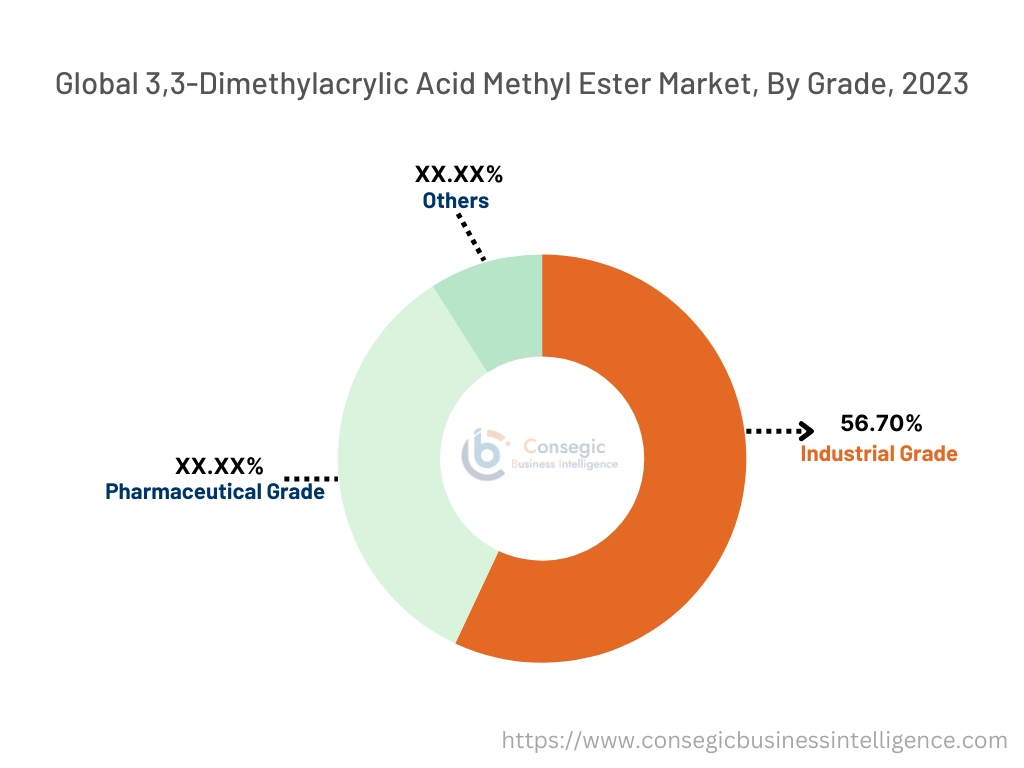
By End-Use Industry:
Based on end-use, the market is segmented into pharmaceuticals, agriculture, chemicals, paints and coatings, and others.
The pharmaceuticals segment accounted for the largest revenue in 3,3-Dimethylacrylic Acid Methyl Ester Market share in 2023.
- The pharmaceutical sector is the primary consumer of 3,3-dimethylacrylic acid methyl ester, leveraging it in the synthesis of APIs and other intermediates for drug production.
- With the increasing prevalence of chronic diseases, the need for advanced drug formulations has risen, boosting advancement for this compound.
- Moreover, the worldwide expansion of pharmaceutical manufacturing facilities, especially in emerging economies, is contributing to the dominance of this segment.
- The stringent focus on quality and regulatory compliance further solidifies its position as a key material in the pharmaceutical sector.
- Pharmaceuticals dominate the market due to the compound’s critical role in drug manufacturing and the growing demand for innovative therapies as per the global analysis.
The agriculture segment is anticipated to register the fastest CAGR during the forecast period.
- In agriculture, is widely used in the formulation of herbicides and pesticides, playing a critical role in enhancing crop protection resulting in 3,3-dimethylacrylic acid methyl ester market expansion.
- The growing global population and the need to improve agricultural productivity to meet rising food demands are key drivers of this segment.
- Additionally, increasing adoption of sustainable farming practices and bio-based agrochemicals is expected to propel the market share for this compound in the agricultural sector.
- Agriculture is expected to grow rapidly, driven by increasing demand for high-performance agrochemicals and the need for sustainable farming solutions.
Regional Analysis:
The regions covered are North America, Europe, Asia Pacific, the Middle East and Africa, and Latin America.
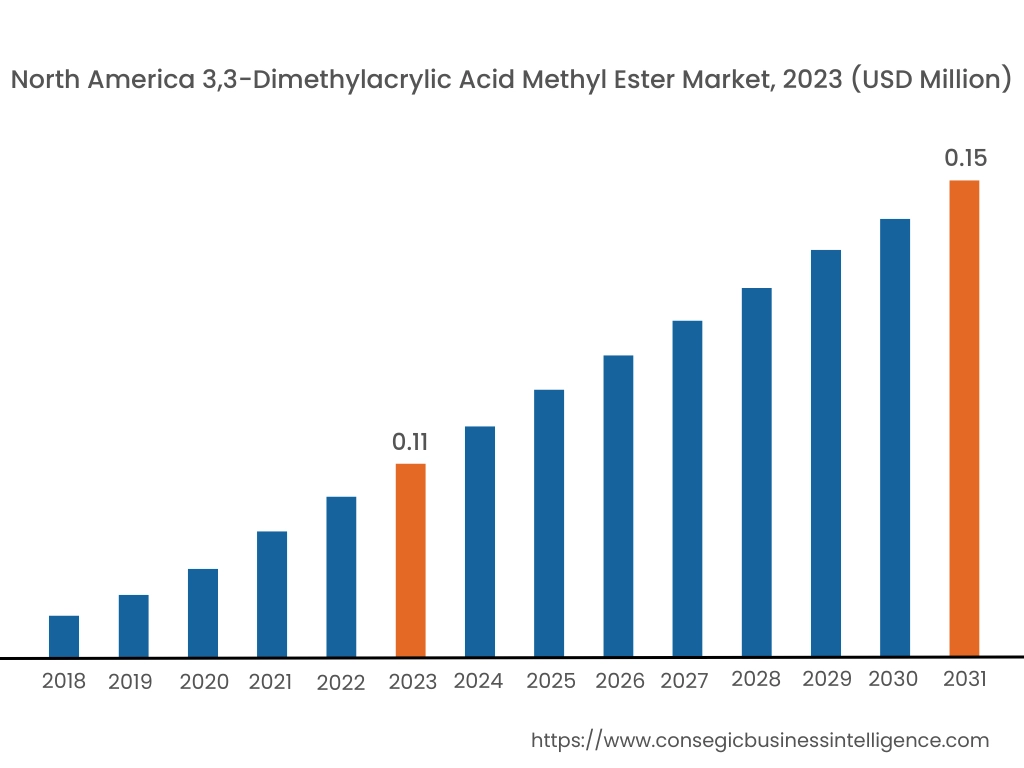
In 2023, North America was valued at USD 0.11 Million and is expected to reach USD 0.15 Million in 2031. In North America, the U.S. accounted for the highest share of 73.60% during the base year of 2023. North America holds a significant share of the ester market, driven by its application in the pharmaceutical and chemical industries. The U.S. dominates the region with increasing use of this compound in the synthesis of specialty chemicals and active pharmaceutical ingredients (APIs). The growing 3,3-dimethylacrylic acid methyl ester market demand for advanced intermediates in drug development and agrochemicals supports the market extension. Canada contributes through its focus on chemical research and industrial applications of intermediates. However, strict regulatory frameworks surrounding chemical production and environmental safety may pose challenges to market growth.
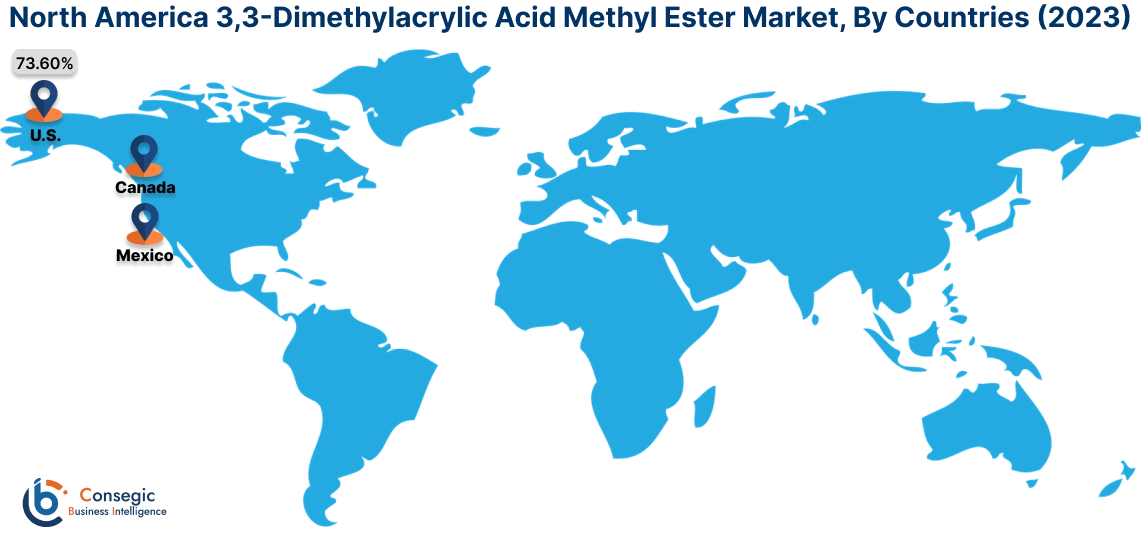
In Asia Pacific, the market is experiencing the fastest growth with a CAGR of 4.6% over the forecast period. Asia-Pacific is the fastest-growing region in the 3,3-dimethylacrylic acid methyl ester market analysis, fueled by rapid industrialization, expanding pharmaceutical manufacturing, and agrochemical production in China, India, and Japan. China leads the region with its large-scale chemical manufacturing capabilities and growing use of this compound in synthesizing agrochemicals and specialty intermediates. India’s burgeoning pharmaceutical sector supports the demand for high-quality chemical intermediates, while Japan leverages advanced technologies to produce high-purity derivatives for electronics and healthcare applications. However, fluctuating raw material prices and inconsistent regulatory frameworks in some countries may pose challenges to market stability. Europe is a key stakeholder in 3,3-dimethylacrylic acid methyl ester market trends, supported by its well-established chemical and pharmaceutical sectors. Countries like Germany, France, and Switzerland are leading contributors. Germany’s strong chemical manufacturing base drives the adoption of this compound in producing specialty chemicals and polymers. France emphasizes its use in pharmaceutical formulations, while Switzerland focuses on high-purity intermediates for pharmaceutical and biotech applications. However, stringent EU regulations on chemical safety and environmental impact can increase production costs and create compliance challenges for manufacturers.
The Middle East & Africa region is witnessing steady growth in the 3,3-dimethylacrylic acid methyl ester market opportunities, driven by increasing industrialization and rising investments in pharmaceutical and chemical sectors. Countries like Saudi Arabia and the UAE are focusing on expanding their chemical manufacturing capabilities, leveraging this compound in specialty applications. In Africa, South Africa is emerging as a market for chemical intermediates in agrochemicals and pharmaceuticals. However, limited local production capabilities and reliance on imports for advanced chemicals may restrict broader market development in the region.
Latin America is an emerging commerce for 3,3-dimethylacrylic acid methyl ester market trends, with Brazil and Mexico leading the region. Brazil’s agrochemical sectors drive growth for this compound in pesticide and herbicide formulations, while Mexico’s growing pharmaceutical and chemical sectors utilize it in API synthesis and specialty chemicals. The region also shows interest in exporting chemical intermediates to North America and Europe. However, economic instability and inconsistent regulations on chemical production may hinder broader market penetration in certain countries.
Top Key Players and Market Share Insights:
The 3,3-Dimethylacrylic Acid Methyl Ester market is highly competitive with major players providing products and services to the national and international markets. Key players are adopting several strategies in research and development (R&D), product innovation, and end-user launches to hold a strong position in the global 3,3-dimethylacrylic acid methyl ester market. Key players in the 3,3-dimethylacrylic acid methyl ester industry include -
- WeylChem Group (Germany)
- Synerzine (USA)
- Hangzhou Longshine Bio-Tech Co., Ltd. (China)
- Vortex Products Ltd. (China)
- Spectrum Chemicals Mfg. Corp. (USA)
- Aurora Chemical (China)
- Bangli Chemical (China)
- Liye Chemical (China)
- Gansu Zeyou New Material (China)
- Shandong Xinhua Pharma (China)
3,3-Dimethylacrylic Acid Methyl Ester Market Report Insights :
| Report Attributes | Report Details |
| Study Timeline | 2018-2031 |
| Market Size in 2031 | USD 0.47 Million |
| CAGR (2024-2031) | 4.12% |
| By Grade |
|
| By End-Use Industry |
|
| By Region |
|
| Key Players |
|
| North America | U.S. Canada Mexico |
| Europe | U.K. Germany France Spain Italy Russia Benelux Rest of Europe |
| APAC | China South Korea Japan India Australia ASEAN Rest of Asia-Pacific |
| Middle East and Africa | GCC Turkey South Africa Rest of MEA |
| LATAM | Brazil Argentina Chile Rest of LATAM |
| Report Coverage |
|
Key Questions Answered in the Report
What is the projected market size of the 3,3-Dimethylacrylic Acid Methyl Ester Market by 2031? +
3,3-Dimethylacrylic Acid Methyl Ester Market size is estimated to reach over USD 0.47 Billion by 2031 from a value of USD 0.34 Billion in 2023 and is projected to grow by USD 0.35 Billion in 2024, growing at a CAGR of 4.12% from 2024 to 2031.
Which grade segment dominates the market? +
The pharmaceutical grade segment holds the largest revenue share due to its critical role in the synthesis of active pharmaceutical ingredients (APIs) and compliance with stringent quality standards.
What are the key applications of 3,3-Dimethylacrylic Acid Methyl Ester? +
The compound is widely used in polymer production, pharmaceutical synthesis, agrochemical formulations, and specialty coatings, where precision and performance are crucial.
Which end-use industry leads the market? +
The pharmaceutical industry dominates the market, driven by the increasing need for advanced drug formulations and the synthesis of APIs.
